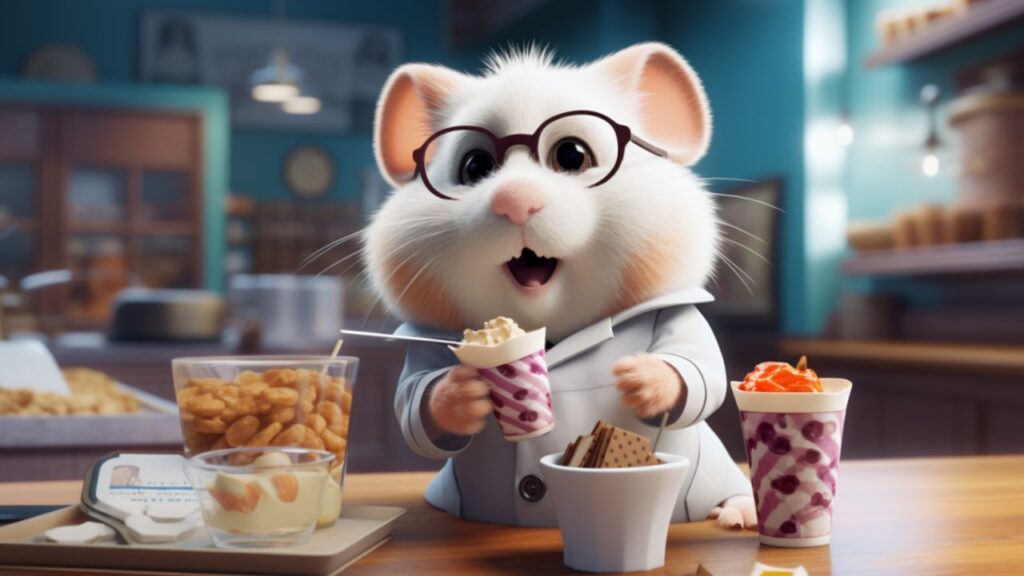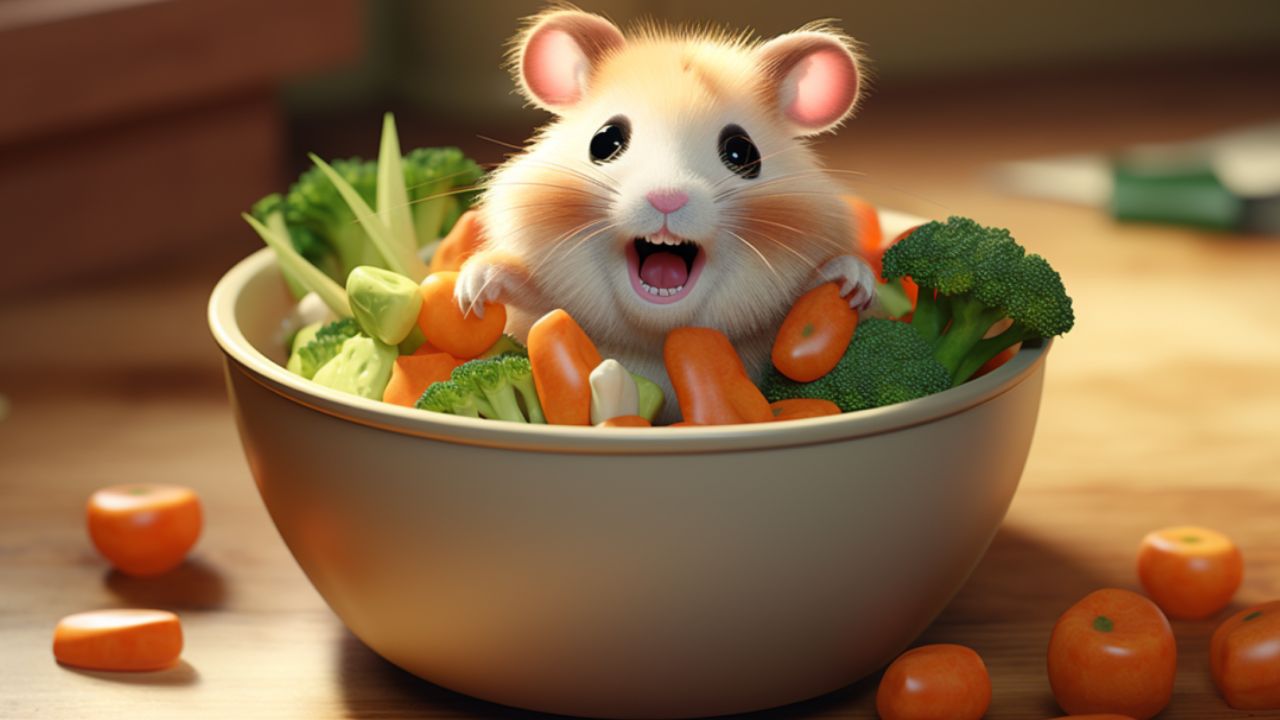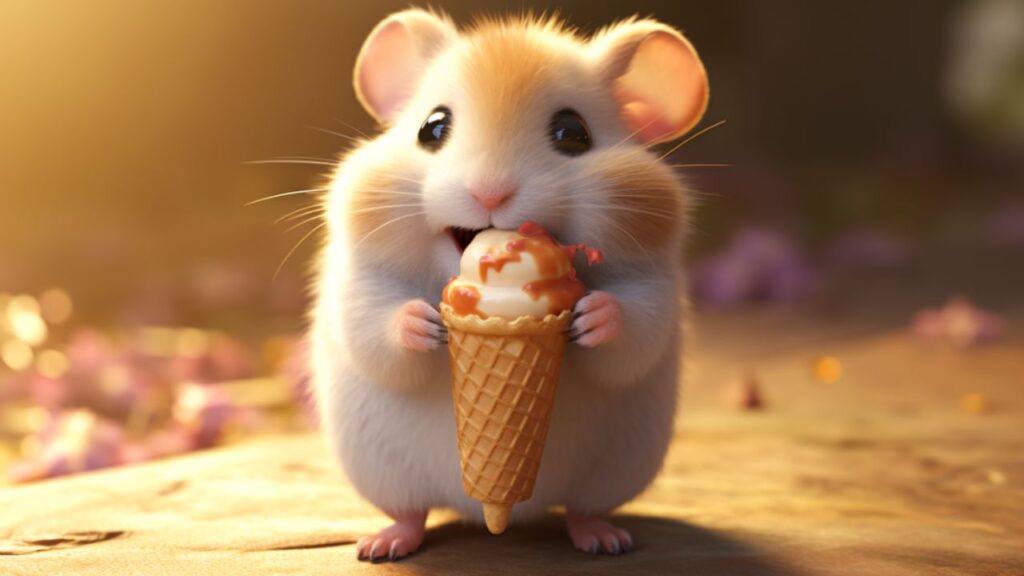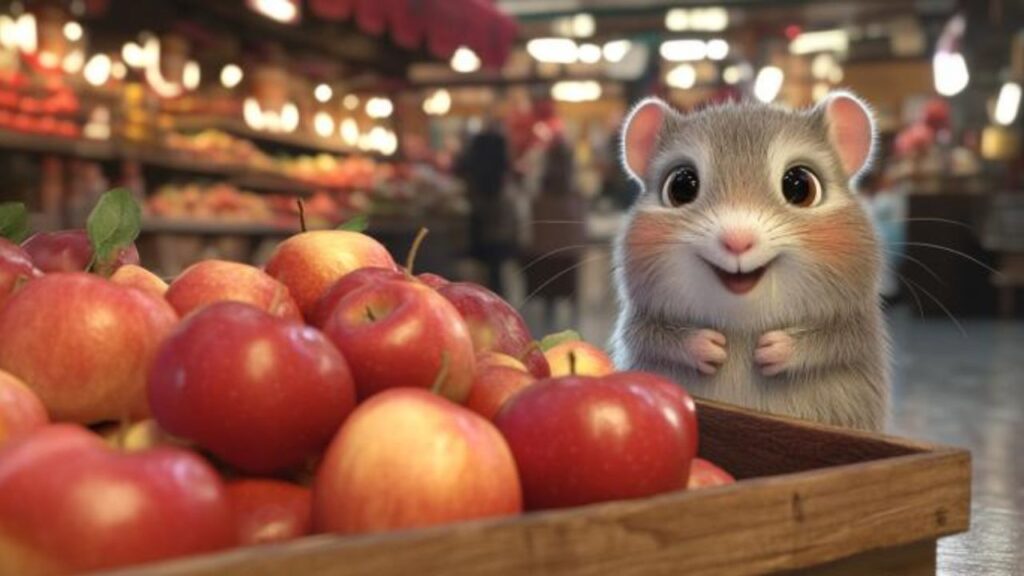TL;DR Summary
Hamsters and Ice Cream: While ice cream is a delightful treat for humans, it’s not ideal for hamsters. The lactose content can be problematic as many hamsters are lactose intolerant, and the high sugar levels aren’t suitable for their health. Moreover, the cold temperature of ice cream can potentially harm them. It’s always best to stick to safer, hamster-specific treats and ensure their diet primarily consists of their regular hamster food. Remember, a happy hamster is a wheel-y happy you!
The mere thought of a tiny hamster enjoying a tinier scoop of ice cream is enough to melt anyone’s heart. With the surge in pet-themed social media content and the growing trend of pet parents treating their little companions as family, it’s no surprise that the question has arisen: can hamsters eat ice cream?
Why Hamster Owners are Curious About Ice Cream
In this digital age, the internet is brimming with videos of pets indulging in human treats, from dogs savoring peanut butter to cats tentatively licking ice pops. Amidst this backdrop, it’s understandable that hamster owners would wonder if their furry friends could also enjoy such delightful treats, especially something as universally beloved as ice cream. After all, who wouldn’t want to share their favorite snack with their tiny companion during a movie night or a lazy Sunday afternoon? The appeal lies not just in the cuteness factor but also in the desire to bond and share experiences with our pets.
The Challenge of Introducing Human Treats to Pet Diets
However, venturing into the world of human treats for pets is not as straightforward as one might think. Just because certain foods are safe and nutritious for humans doesn’t mean they’re suitable for our pets, whose digestive systems and nutritional needs differ greatly from ours. Hamsters, for instance, have specific dietary requirements that ensure their well-being. When introducing any new food item into their diet, we must tread with caution. It’s vital to consider not just the immediate effects but also the long-term implications on their health and longevity. The allure of sharing a treat might be tempting, but the responsibility of ensuring our pet’s health and safety always comes first.
Remember, our pets rely on us to make informed decisions for them. And as Dr. Vivian Whiskerson often says, it’s essential to “know before you treat.” This article aims to address the swirling questions surrounding hamsters and ice cream, ensuring that you’re equipped with all the knowledge you need to make the best choice for your little companion.
The Allure of Ice Cream: Human vs. Hamster

Ice cream is one of those delightful treats that has managed to capture the hearts and taste buds of countless individuals across generations and cultures. The creamy texture, the fusion of flavors, and the sheer joy of a cold treat on a warm day have made ice cream an iconic dessert. But while humans can dive into a tub with gusto, what about our tiny, whiskered friends? Let’s delve into the composition of ice cream and understand its impact on hamsters.
Brief Overview of Ice Cream’s Composition and Appeal
Ice cream primarily consists of milk, cream, sugar, and flavorings. The rich, creamy base is usually derived from dairy products, while sugars, both natural and added, provide the sweet taste that many crave. The incorporation of various flavors, from fruits to chocolates to more exotic ingredients, adds to its widespread appeal. For many of us, ice cream isn’t just about the taste; it’s about memories, comfort, and moments of indulgence.
The Role of Dairy and Sugars in a Hamster’s Diet
Hamsters, by nature, are omnivores, but their natural diet leans more towards seeds, grains, fruits, and the occasional insect. Dairy isn’t a natural component of their diet. While they can digest small amounts, excessive dairy can be problematic. Lactose, the sugar found in milk, can be challenging for some hamsters to digest, leading to stomach upsets or diarrhea.
Furthermore, the sugars found in ice cream, both natural and added, can pose risks. Hamsters have a fast metabolism, but their systems are not equipped to handle high sugar levels. Over time, consistent ingestion of sugary foods can lead to obesity, diabetes, and other health complications in hamsters.
In essence, while the occasional lick might not cause immediate harm, regularly offering ice cream can jeopardize a hamster’s health. The key is understanding and respecting the differences in dietary needs between humans and hamsters.
Potential Implications of Ice Cream for Hamsters

The question of whether hamsters can enjoy human delicacies, especially treats like ice cream, is a matter of concern for many pet parents. While a little nibble here and there might seem harmless, it’s vital to understand the potential repercussions. Ice cream, a dairy-based dessert loaded with sugars and often served cold, can pose several challenges to a hamster’s digestive and overall health.
Lactose Intolerance and Hamsters
Lactose is the primary sugar found in milk and other dairy products. While many animals, including humans, produce an enzyme called lactase to break down lactose, this isn’t always the case with hamsters. Many hamsters have reduced levels of lactase as they age, making them lactose intolerant. Consuming dairy can lead to uncomfortable digestive symptoms for these hamsters, such as bloating, gas, diarrhea, and stomach cramps.
The Sugar Content: Its Effects on Hamster Health
Sugar, both in its natural form and as added sweeteners, is a dominant component of ice cream. While it offers sweetness and pleasure to our palate, the implications for hamsters are less rosy. Hamsters have small bodies and fast metabolisms. Their natural diet in the wild consists primarily of grains, seeds, vegetables, and the occasional protein source like insects. They aren’t accustomed to high sugar intake.
Excessive sugar can cause a rapid spike in a hamster’s blood sugar levels. Over time, if such foods become a regular part of their diet, it can lead to obesity, dental problems, and even diabetes. Diabetes in hamsters is a serious condition that requires careful monitoring and can drastically reduce their lifespan.
Temperature Considerations: Can Cold Foods Harm Hamsters?
Temperature plays a crucial role in a hamster’s environment and diet. These creatures are sensitive to sudden temperature changes. Feeding them ice-cold treats, like ice cream, can lead to a shock to their system. Sudden exposure to cold can slow down their digestive process, leading to potential digestive issues. Moreover, the extreme cold can lower their body temperature, which, in severe cases, can lead to hypothermia. While the likelihood is rare, it’s a risk that can be easily avoided.
In summary, while the idea of sharing a beloved treat with our furry friends is tempting, it’s essential to prioritize their health and well-being. By understanding the implications of ice cream and other such treats, we can make informed decisions that ensure our hamsters live a long, healthy, and happy life.
Alternative Treat Options

The innate curiosity of hamsters can sometimes tempt pet owners to introduce a myriad of treats, often sourced from human foods, to these tiny critters. While the intention is usually to bring joy and perhaps even a semblance of shared mealtime, it’s crucial to ensure that these treats are safe and beneficial. Knowing that certain human favorites, like ice cream, might not be the best for our furry pals, we can pivot towards healthier alternatives that still offer excitement without compromising on their health.
Healthier Treat Alternatives for Hamsters
When we think of treats, it doesn’t always have to be a sugary delight. For hamsters, the novelty often lies in the variety and texture rather than sweetness. Here are some safer treat options:
- Fresh Vegetables: A tiny piece of cucumber, carrot, or broccoli can be a refreshing treat. These provide hydration and essential nutrients.
- Fruits: While fruits do contain natural sugars, they’re a healthier option when given in moderation. Bits of apple (without seeds), blueberries, or strawberries can be occasional treats.
- Protein Sources: Hamsters, especially Syrian hamsters, appreciate the occasional protein boost. Boiled eggs, plain cooked chicken, or even mealworms can be a treat they’d relish.
- Whole Grains: Cooked plain brown rice, quinoa, or even a small piece of whole grain bread can be a delightful change for them.
- Herbs: Fresh herbs like basil or parsley can be a flavorful treat, and they also come with the added benefit of freshening up their tiny breaths!
The Importance of Moderation and Occasional Treats
No matter how nutritious, every treat should follow the golden rule of moderation. While it’s delightful to see our hamsters nibble on something new, their primary diet of hamster pellets should remain central. Treats are just that – an occasional indulgence.
Regularly introducing a variety of treats can disrupt their dietary balance. For instance, too much fruit can still lead to sugar-related health issues, and excessive protein can lead to obesity. Therefore, it’s essential to maintain a balance and ensure that treats remain an occasional joy, rather than a regular part of their diet.
In the end, the health and happiness of our hamsters are intertwined with their dietary choices. By providing them with a balanced diet and introducing treats thoughtfully and sparingly, we pave the way for a fulfilling, joyful, and healthy life for our whiskered companions.
Whisker Tips: Navigating the Treat Terrain with Care

Navigating the world of treats for our tiny, whiskered companions can be both an exciting adventure and a daunting challenge. The sheer joy we feel watching them nibble on a new treat is undeniably heartwarming. However, this journey of culinary exploration for our pets comes with its own set of responsibilities. Here in the Whisker Tips section, we aim to provide a comprehensive guide on safely introducing new delicacies into your hamster’s diet and understanding the signs when something’s amiss.
Best Practices for Introducing Novel Treats to Hamsters
- Sizing it Right: Hamsters, despite their voracious appetites, are tiny beings. Their stomachs can only handle so much. So, when you’re introducing a new treat, always offer it in minuscule portions. This not only ensures they don’t overeat but also allows you to monitor any reactions.
- Singular Introductions: In the excitement of discovering new treats, one might be tempted to offer a hamster a mixed platter. However, it’s crucial to introduce just one new item at a time. This approach aids in pinpointing any specific intolerances or allergies should they arise.
- The Observation Window: After treating your hamster, it’s of utmost importance to keep a close watch for at least 24 hours. This vigilance helps in spotting any subtle changes, be it in their behavior, appetite, or even the nature of their droppings.
- Hydration is Key: With new treats, especially those salty or sugary, comes an increased need for hydration. Always ensure your hamster’s water source is replenished, clean, and easily accessible.
- Storing with Care: Proper storage can often be the dividing line between a healthy treat and a harmful one. Always store perishables adequately, and for fruits or veggies, ensure they’re fresh, thoroughly cleaned, and devoid of any harmful chemicals.
Warning Signs to Be Wary Of Post-Treat
- Lethargy Overdrive: A sudden dip in your hamster’s energy levels post-treat consumption could be indicative of discomfort, or worse, a pressing health issue.
- Droppings Dilemma: Soft droppings, or even diarrhea, can be an alarming sign of an upset tummy resulting from the treat.
- Loss of Appetite: If your hamster starts shying away from its food after trying a new treat, it could be signaling an adverse reaction or discomfort.
- Thirst Alert: An unusual increase in water consumption might hint at an excessively salty or sweet treat, potentially pushing your hamster towards dehydration.
- Itchy and Scratchy: Any signs of increased scratching, skin redness, or irritation could be symptomatic of an allergic reaction to the new food.
Exploring the extensive realm of hamster treats is indeed a delightful endeavor, but it’s paramount to tread with caution and knowledge. By being observant, informed, and always prioritizing our hamster’s health, we can ensure that every treat-time is a memorable, joy-filled experience without any hiccups.
Ice Cream for Hamsters – A Cooling Treat or a Cautionary Tale?

As we scoop into the final thoughts on this icy topic, it’s imperative to sift through the sweetness and get to the core of our findings. Our little hamster companions often become part of our families, prompting us to share life’s joys with them, including our favorite treats. But, as with many aspects of pet care, it’s essential to understand and prioritize what’s truly best for them, setting aside our human inclinations. Let’s take a moment to recap our journey and arrive at a definitive answer on the great ice cream debate for hamsters.
Delving Deeper into the Ice Cream Debate for Hamsters: Can Hamsters Eat Ice-Cream
Navigating the world of human treats in relation to our tiny, furry counterparts is nothing short of a maze. Our recent deep dive into the domain of ice cream and its potential impact on hamsters stands as a testament to this complexity. The allure of sharing those joyous moments with our pets as we indulge in a creamy scoop is strong, yet, as responsible pet owners, understanding the implications of such actions is vital.
At the heart of the debate lies the essence of ice cream itself. Crafted to perfection over centuries, this dessert has evolved to satisfy human taste buds, primarily focusing on a blend of sweetness, creaminess, and coldness. However, as we unravel the layers behind this delicious treat, we confront some significant concerns for our whiskered friends.
The first stumbling block is the primary ingredient: dairy. While many humans consume it without a second thought, introducing lactose into a hamster’s diet can be a tricky proposition, given their sensitivity to it. The ramifications of lactose intolerance in hamsters are not to be taken lightly.
Then there’s the sugar. Sugar, in its various forms, is omnipresent in most ice cream variants. For humans, sugar offers a quick energy boost and lends the dessert its characteristic sweetness. But for hamsters, excessive sugar can lead to a plethora of health issues, ranging from obesity to dental problems.
Last but not least, we must consider the temperature aspect. The icy nature of ice cream is a refreshing escape for humans, especially during hot summers. Yet, for hamsters, this cold treat might not be as benign, potentially causing digestive distress or even temperature shocks.
In conclusion, as tantalizing as the idea of bonding over a shared scoop might be, our in-depth analysis underscores the importance of prioritizing the well-being of our hamster companions. The risks, as highlighted, far outweigh the fleeting moments of shared indulgence.
A Parting Thought on Hamster Care
Embarking on the journey of hamster guardianship is a delightful yet intricate dance of understanding, compassion, and informed decision-making. Every choice we make, from their bedding to their treats, has repercussions. It’s our solemn duty, as caretakers, to ensure these choices always tilt towards their optimal health and happiness.
The debate around offering a delightful scoop of ice cream to our whiskered pals perfectly encapsulates this balance. While the allure of sharing a cherished human treat with our tiny companions might seem like an act of love, sometimes true love is expressed in restraint. It’s about recognizing that their dietary needs differ vastly from ours and that what brings us joy might not necessarily be in their best interest.
So, as we indulge in the creamy sweetness of our favorite frozen dessert, let’s also remember to shower our hamsters with treats that are tailor-made for their unique nutritional needs. After all, their happiness and well-being are intrinsically tied to our own joy. And as always, keep in mind: a thrilled and thriving hamster makes for a wheel-y delighted and contented you!




